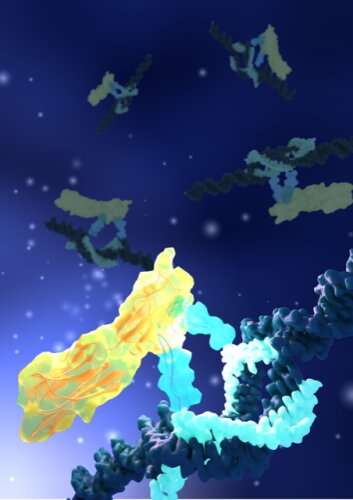Discovering new drugs, inspired by Darwinian theory

The body must constantly defend itself against bacteria and viruses. It generates millions of different antibodies, which are selected to recognize the enemy and trigger the best possible immune response. Scientists use these antibodies for therapeutic purposes to target proteins and disrupt their harmful effects. However, identifying small molecules that will form the basis of drugs is a long and tedious process.
Chemists at the University of Geneva (UNIGE), Switzerland, have developed a technique inspired by the theory of Darwinian evolution: Amplifying the best combinations and generating diversity that allows biology to find solutions to new problems. They have created a new methodology that rapidly generates millions of combinations of small molecules through programmed assembly using DNA-pairing processes, finding the best possible combination to counter a target protein within two weeks. These results, published in the journal Nature Chemistry, will open up a new and untapped space for drug development.
The way drugs work is based on the molecular recognition of a target protein involved in a disease, and then disarming it. To do this, scientists use high-throughput screening to identify which molecule could become a drug, specifically targeting the protein of interest. Over the last ten years, the technique has been improved by encoding small molecules with DNA tags that simplify their identification, as DNA is easy to decode.
Drawing inspiration from Darwinian evolutionary forces to find efficient assemblies
"Biology always finds a solution to a problem, explains Nicolas Winssinger, professor in the Department of Organic Chemistry at the Faculty of Science, UNIGE, and the corresponding author of the study. This is the principle of natural evolution, which consists of amplifying the best individuals, while generating diversity to adapt and survive changing conditions. That's what we've set up for small molecules." Indeed, the scientists have developed a technology that generates diversity by creating more than 100 million assemblies of molecules via their DNA, from which they then select to best match a particular protein.
"We were inspired by the characteristics of antibodies that recognize target proteins and sought to mimic them in the form of simpler molecules to allow them to be assembled in different combinations, directed by DNA sequences," explains Nicolas Winssinger. These combinations are then selected and amplified several times to find the best possible match with the protein to be targeted, all in one to two weeks, compared with months or even a year for traditional high-throughput screening.
A proven, easily reproducible and inexpensive technique
To validate the effectiveness of this methodology, the Geneva team focused on the PD-L1 protein, which protects cancer cells by diverting the immune system. "Thanks to our methodology, we quickly identified an assembly that specifically targets PD-L1, confirming that it works effectively," says Nicolas Winssinger.
This technique, which is easy to reproduce in any laboratory in the world, costs only a few thousand francs, compared with millions for high-throughput screening. "By exploiting the evolutionary forces highlighted by Darwin, we can now improve our molecular assemblies and open up a new space of possible combinations that has not yet been exploited, in order to create new, more effective drugs," concludes the Geneva researcher.
More information: Balayeshwanth R. Vummidi et al, A mating mechanism to generate diversity for the Darwinian selection of DNA-encoded synthetic molecules, Nature Chemistry (2021). DOI: 10.1038/s41557-021-00829-5
Journal information: Nature Chemistry
Provided by University of Geneva





















